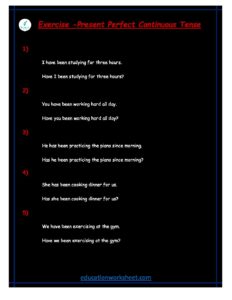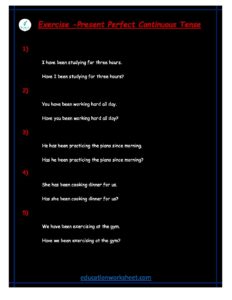changing Present Perfect Continuous Tense to positive and interrogative worksheets
changing Present Perfect Continuous Tense to positive and interrogative
Positive Form:
The positive form of the Present Perfect Continuous tense is used to make affirmative statements about actions that have been ongoing. To construct a positive sentence, you need to follow a specific structure:
Subject + have/has + been + present participle (-ing form of the verb) + the rest of the sentence.
Here are some examples of changing Present Perfect Continuous sentences into positive statements:
- Original Sentence: “She has been studying English for two hours.” Positive Form: “She has been studying English for two hours, and she’s making great progress.”
- Original Sentence: “They have been playing soccer all afternoon.” Positive Form: “They have been playing soccer all afternoon, and they’re exhausted now.”
- Original Sentence: “I have been working on this project for a long time.” Positive Form: “I have been working on this project for a long time, and it’s finally nearing completion.”
In each of these examples, we have maintained the basic structure of the Present Perfect Continuous tense while providing additional information to make the statements more informative and contextually relevant.
changing Present Perfect Continuous Tense to positive and interrogative worksheets

Interrogative Form:
Interrogative sentences are used to ask questions, and the interrogative form of the Present Perfect Continuous tense helps us inquire about ongoing actions. To create an interrogative sentence in this tense, you should use the following structure:
[Have/Has + subject + been + present participle (-ing form of the verb)] + the rest of the sentence + ?
Here are some examples of changing Present Perfect Continuous sentences into interrogative questions:
- Original Sentence: “Has she been studying English for two hours?” Interrogative Form: “Has she been studying English for two hours, or did she take a break?”
- Original Sentence: “Have they been playing soccer all afternoon?” Interrogative Form: “Have they been playing soccer all afternoon, or did they switch to another activity?”
- Original Sentence: “Have I been working on this project for a long time?” Interrogative Form: “Have I been working on this project for a long time, or did I just start recently?”
In these interrogative examples, we’ve utilized the auxiliary verb “have” or “has” at the beginning of the sentence to indicate the question’s tense, followed by the subject and the rest of the sentence. The addition of the question mark “?” at the end of the sentence makes it clear that we are seeking information.
Usage and Context:
Understanding when to use the Present Perfect Continuous tense is crucial for constructing meaningful positive and interrogative sentences. This tense is generally employed when an action began in the past and is still in progress or has just recently stopped. It emphasizes the duration of the action and its relevance to the present moment.
Positive and interrogative forms of the Present Perfect Continuous tense are commonly used in everyday conversation, written communication, and formal writing. They allow us to convey information, ask questions, and express ongoing or recently completed activities accurately.
Examples of Usage:
- Positive Form:
- “They have been working on this project tirelessly.”
- “She has been studying medicine for many years.”
- “I have been practicing the piano since I was a child.”
- Interrogative Form:
- “Have you been learning French for a while now?”
- “Has he been traveling around the world recently?”
- “Have they been living in this neighborhood for a long time?”
changing Present Perfect Continuous Tense to positive and interrogative worksheets

In conclusion, understanding how to change Present Perfect Continuous sentences into positive and interrogative forms is essential for effective communication in English. By following the established structures and rules, you can express ongoing actions, ask questions, and provide detailed information about various situations. Practice and familiarity with these forms will help you become more proficient in using the Present Perfect Continuous tense in your language skills, whether in speaking, writing, or comprehension.
changing Present Perfect Continuous Tense to positive and interrogative Empower your language prowess with our comprehensive worksheets on changing Present Perfect Continuous Tense to positive and interrogative forms. Unravel the complexities of this dynamic tense, perfect for describing ongoing actions with a connection to the present. Practice transforming sentences effortlessly and gain confidence in expressing continuous actions. Download now to enrich your language proficiency and embark on a fulfilling journey towards mastery

